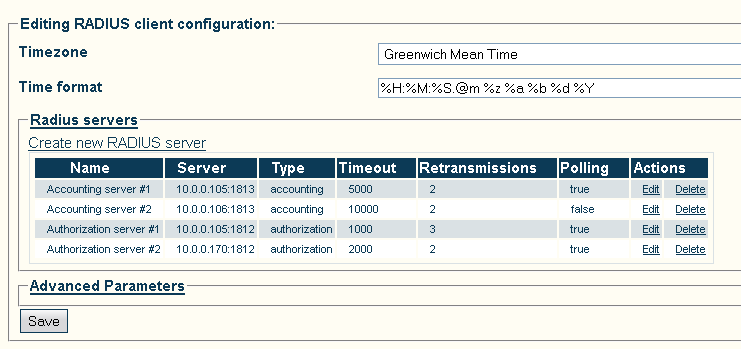Toolpack:Adding RADIUS server B
From TBwiki
(Difference between revisions)
| Line 18: | Line 18: | ||
*'''Server IP address''' is the IP address of the RADIUS server. | *'''Server IP address''' is the IP address of the RADIUS server. | ||
*'''Server UDP port''' is the UDP port of the RADIUS server. | *'''Server UDP port''' is the UDP port of the RADIUS server. | ||
| − | *''' | + | *'''Public IP address''' The IP address that will be set in the NAS-IP-Address attribute, when present. This is used when the RADIUS client is behind a NAT. Leave this field empty in order to use the source IP address instead. |
| + | *'''Timeout''' The time to wait (in milliseconds or seconds) for a response from the RADIUS server before retrying. | ||
*'''Retries''' is the number of times to send the same request again when the timeout is reached. See full details on functionality here: [[CDR redundancy]] | *'''Retries''' is the number of times to send the same request again when the timeout is reached. See full details on functionality here: [[CDR redundancy]] | ||
*'''Server type''' is the type of RADIUS server this configuration corresponds to. The choices are '''Accounting''' for CDR functionality and '''Authorization''' for authentication and authorization. | *'''Server type''' is the type of RADIUS server this configuration corresponds to. The choices are '''Accounting''' for CDR functionality and '''Authorization''' for authentication and authorization. | ||
*'''Use polling (Status-Server)''' dictates if polling with the Status-Server message is supported by this server. When enabled, this option allows the RADIUS client to recognize quickly and efficiently if the RADIUS server is available or not. | *'''Use polling (Status-Server)''' dictates if polling with the Status-Server message is supported by this server. When enabled, this option allows the RADIUS client to recognize quickly and efficiently if the RADIUS server is available or not. | ||
| + | *'''Polling Delay''' The time to wait (in milliseconds or seconds) before polling the server. | ||
*'''Server secret''' is the passphrase to authenticate the TMG on the RADIUS server. | *'''Server secret''' is the passphrase to authenticate the TMG on the RADIUS server. | ||
Revision as of 11:39, 12 March 2013
Applies to version(s): v2.7
Multiple RADIUS servers can be configured to provide RADIUS redundancy.
1- Select RADIUS from the navigation panel.
2- In the Editing RADIUS client configuration page, select Create new RADIUS server
3- Configure the RADIUS server with these parameters:
- Name to recognize the server.
- Server IP address is the IP address of the RADIUS server.
- Server UDP port is the UDP port of the RADIUS server.
- Public IP address The IP address that will be set in the NAS-IP-Address attribute, when present. This is used when the RADIUS client is behind a NAT. Leave this field empty in order to use the source IP address instead.
- Timeout The time to wait (in milliseconds or seconds) for a response from the RADIUS server before retrying.
- Retries is the number of times to send the same request again when the timeout is reached. See full details on functionality here: CDR redundancy
- Server type is the type of RADIUS server this configuration corresponds to. The choices are Accounting for CDR functionality and Authorization for authentication and authorization.
- Use polling (Status-Server) dictates if polling with the Status-Server message is supported by this server. When enabled, this option allows the RADIUS client to recognize quickly and efficiently if the RADIUS server is available or not.
- Polling Delay The time to wait (in milliseconds or seconds) before polling the server.
- Server secret is the passphrase to authenticate the TMG on the RADIUS server.
4- You can configure multiple RADIUS servers to have RADIUS redundancy. Each entry can have different settings.



